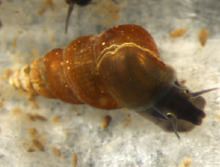Superfamily Rissooidea Subfamily Pomatiopsinae Rank Species | Genus Oncomelania Higher classification Oncomelania | |
 | ||
Similar Oncomelania, Schistosoma japonicum, Pomatiopsidae, Gastropods, Schistosoma haematobium | ||
Oncomelania hupensis is a species of very small tropical freshwater snail, an aquatic gastropod mollusk in the family Pomatiopsidae.
Contents
Distribution
Oncomelania hupensis has been found in China, and also in Japan, Philippines, and Indonesian island of Sulawesi.
Description
Over the past a few decades, the taxonomy of Oncomelania hupensis has been a dispute due to the variation in morphological characters such as shell sculpture, operculum etc. Phenotypically, Oncomelania hupensis can be separated into ribbed- and smooth- shelled morphotypes. In China, the typical morphotype of Oncomelania hupensis is ribbed-shelled, and its distribution is restricted to Yangtze River basin. Smooth-shelled snails are also distributed in mainland China, but are considered as the same species and subspecies of Oncomelania hupensis.
Oncomelania hupensis reported in other Far East countries are smooth-shelled, and have been considered either as subspecies of Oncomelania hupensis or independent species in this genus.
Subspecies
There are 4 subspecies of Oncomelania hupensis in China: hupensis, robertsoni, tangi and guangxiensis.
Genetic confirmation of thsese four Chinese subspecies: Based on shell form, biogeographical and allozyme data, Davis et al. (1995) distinguished 3 subspecies of the Oncomelania hupensis in mainland China. However, Zhou et al. (2008) separated the Oncomelania hupensis guangxiensis out from Oncomelania hupensis tangi based on allozymes and amplified fragment length polymorphism (AFLP), which was verified recently by Li et al. with internal transcribed spacer (ITS) and 16S fragments.
Genetics
It may also be possible that continuous control efforts, such as routine molluscicides in China, which have been used to control snails for about fifty years, might have imposed some effect on population genetics of these snails.
The complete mitochondrial genome of Oncomelania hupensis has been released in 2010.
Habitat
It is seasonally amphibious species which lives in lakes and on marshy ground.
The habitats of Oncomelania hupensis in the middle and lower reaches of the Yangtze River include lake/marshland regions and hill regions, both of which have extensive physical connections with the Yangtze River through channels or in low floodplains beside the Yangtze River. With frequent floodings of the Yangtze River, snails in these habitats can be dispersed and subsequently deposited widely in various localities. The accumulation of mixed sources of snails can then generate genetically diversified populations of snails, leading to the existence of various haplotypes.
In Sichuan and Yunnan provinces in the upper reaches of the Yangtze River, Oncomelania hupensis robertsoni are distributed in mountainous areas, and are not subjected to flood influence as much as in the middle and lower reaches of the river. It is interesting to see that a relatively lower number of haplotypes were found in this region as compared with Oncomelania hupensis hupensis. It appears likely that there has been certain degree of isolation for these mountainous populations.
Parasites
This freshwater snail is significant medically, because it is an important vector of parasitic infection in the tropics and subtropics. It can serve as vectors for two serious human diseases: the schistosomiasis blood fluke parasite, and the paragonimus lung fluke parasites.
Oncomelania hupensis is the unique intermediate host of Schistosoma japonicum, which causes schistosomiasis endemic in the Far East, and especially in mainland China. Oncomelania hupensis largely determines the parasite's geographical range.
